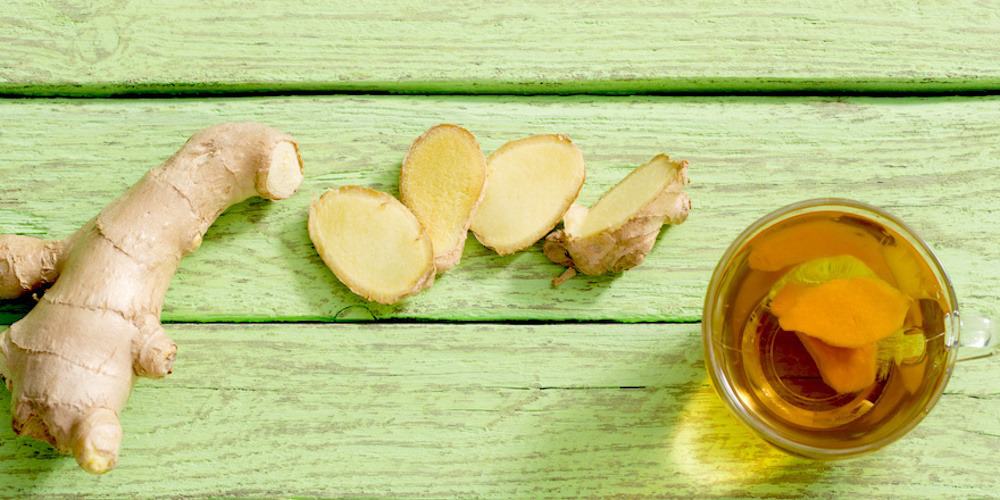BENEFITS OF GINGER
✓ Anti-inflammatory
✓ Strengthens the immune system
✓ Antioxidant
✓ Anti-nausea and vomiting
✓ Improves digestion
{{{TEMP_MARK_66}}}
Ginger (Zingiber officinale) is a tropical flowering plant from the Zingiberaceae family, originally from India, where its fleshy rhizome has been used in cooking and consumed for therapeutic purposes for 4000 years. This spice, a cousin of turmeric and cardamom, is now produced in other Asian countries, China, Indonesia, in Africa (notably Nigeria) but also in Australia and Peru.
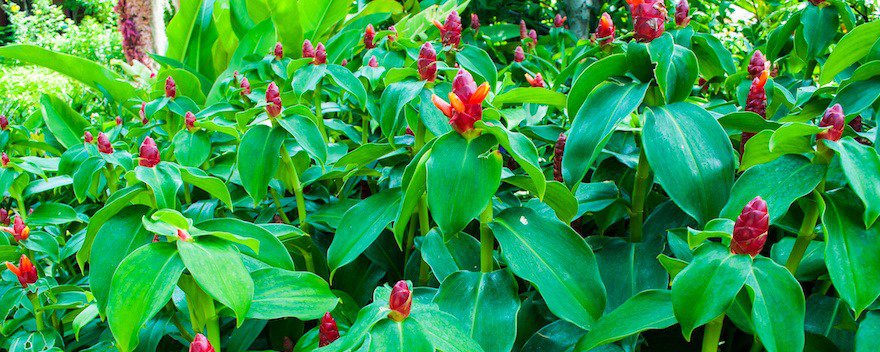
In Ayurvedic medicine, traditional Indian medicine, ginger is considered a cornerstone, a universal remedy. It is mainly attributed anti-inflammatory, antioxidant, anti-nausea, and anti-infectious benefits. One of its bioactive compounds, gingerol, is responsible for its pungent flavor, the warmth it provides, and its numerous virtues.
En effet, son principal composé phénolique est le gingérol, aussi appelé [6]-gingérol. Lorsque le rhizome est cuit ou séché, le gingérol devient du zingerone et du shogaol, aux propriétés similaires.
It is the very high concentration of gingerol in ginger that makes it an ultra-healthy and beneficial food for the body in every way.
Besides, ginger is often thought to be an aphrodisiac… A reputation that dates back, since in antiquity, Pliny the Elder, author of the famous Natural History, already mentioned this virtue. This aspect is also mentioned in the Kama Sutra. As for Countess du Barry, she incorporated it into her love potions. Its vasodilator action would facilitate the flow of blood for an erection, and its taste would stimulate sexual appetite.
{{{TEMP_MARK_38}}}
To date, no scientific study has proven it to be truly aphrodisiac, but it is ingrained as such in our imagination.
The etymology of ginger takes us on a bit of a journey: the word comes from Latin zingiber, derived from the Greek zingiberis, which itself comes from the Arabic zangabil, borrowed from the Sanskrit srngaveram which describes its shape since it means “horn-shaped”.
It is characterized by its pungent and lemony flavor, a spice used in many Asian cuisines (Indian, Indonesian, Japanese, Chinese…) and now Western cuisines. It is also found in candy form, confit, gingerbread, and beers (ginger beers), but in this context, it is difficult to benefit from its therapeutic virtues! Ideally, it should be eaten fresh, dried in powder, or in infusion.
Nutritional Composition
-
{{{TEMP_MARK_86}}}
- Active principles: gingerol, shogaol, paradol, zingerone
{{{TEMP_MARK_84}}}
{{{TEMP_MARK_48}}}
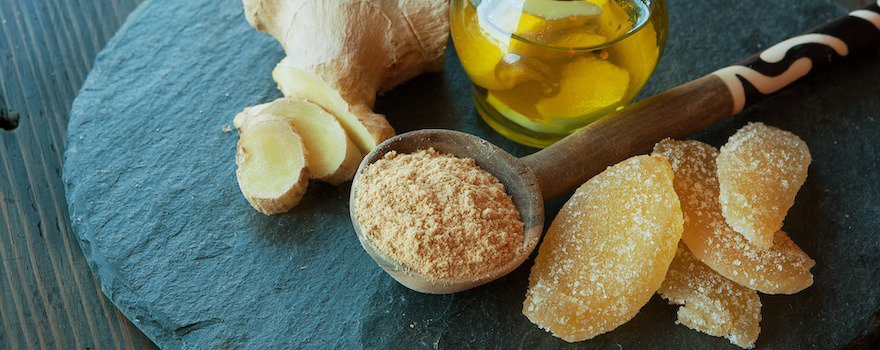
Benefits of Ginger
🌵 Anti-inflammatory
{{{TEMP_MARK_28}}}
Its anti-inflammatory action is primarily attributed to the gingerols, shogaols, and paradols it contains. It helps to reduce different types of inflammatory-related pain (muscular, joint, menstrual…).
This study from the Miami Veterans Affairs Medical Center and the University of Miami demonstrated that consuming concentrated extracts helps reduce the symptoms of knee osteoarthritis.
🛡 Strengthens the immune system
Ginger is anti-infectious, it has antimicrobial and antiviral properties and will stimulate the immune system. This is why it is recommended in cases of cold, sore throat, and flu conditions.
This study from the K.S. Rangasamy College of Arts and Science in India demonstrated its antibacterial properties.
{{{TEMP_MARK_58}}}
Ginger is among the most antioxidant foods. It contains around forty antioxidant agents, notably gingerol, which helps combat cellular aging.
Some antioxidants present in the rhizome are released when cooked, so you can also eat it cooked for this purpose.
{{{TEMP_MARK_24}}}
🙊 Anti-nausea and vomiting
Ginger is an antiemetic: It is particularly effective for combating nausea and vomiting regardless of their cause (pregnancy, motion sickness, post-surgery, post-chemotherapy…). To benefit from this property, it is recommended to consume it in powder form.
The gingerols and shogaols it contains are responsible for this property, as they would reduce stomach movements.
Since 1999, the WHO has recognized ginger as an effective preventative against nausea and vomiting in pregnant women.
{{{TEMP_MARK_13}}}
♻️ Improves digestion
{{{TEMP_MARK_27}}}
This study from the Kaohsiung Medical Center in Taiwan showed that it accelerates stomach emptying and stimulates digestion.
🍳 Anti-cholesterol
{{{TEMP_MARK_47}}}
{{{TEMP_MARK_8}}}
🔬 Potentially anti-cancer
Ginger may play a role in cancer prevention thanks to gingerol. Research still needs to establish the mechanisms truly at work and its effectiveness in cancer prevention and treatment.
This study from the Michigan Medical School in the United States conducted on 30 people showed that consuming 2g of ginger extract helps reduce the risks of inflammation and colon cancer.

{{{TEMP_MARK_83}}}
Ginger is probably one of the most accessible superfoods: widely available in all food stores, even organic, this spice remains inexpensive, and its positive effects are numerous.
💡Effects on nausea: several studies have shown that ginger is effective in relieving nausea, whether caused by pregnancy, chemotherapy, or motion sickness, ginger infusion can help if you enjoy the taste. Always ask for your doctor’s advice if you are taking other medications, as there may be interactions, especially with anticoagulants.
💡Digestive comfort: Due to its action on gastric emptying, it helps to soothe digestive discomfort after a heavy meal. However, be careful not to overuse it, as in large quantities, it can cause heartburn in some people.
💡Cold relief: while unfortunately, there is no cure for the common cold, it is entirely possible to alleviate the symptoms. For this, ginger is a good ally: in tea, combined with lemon and honey, it soothes coughs and eases flu-like symptoms.
Perrine Bellanger – dietitian nutritionist
How to consume ginger?
{{{TEMP_MARK_82}}}
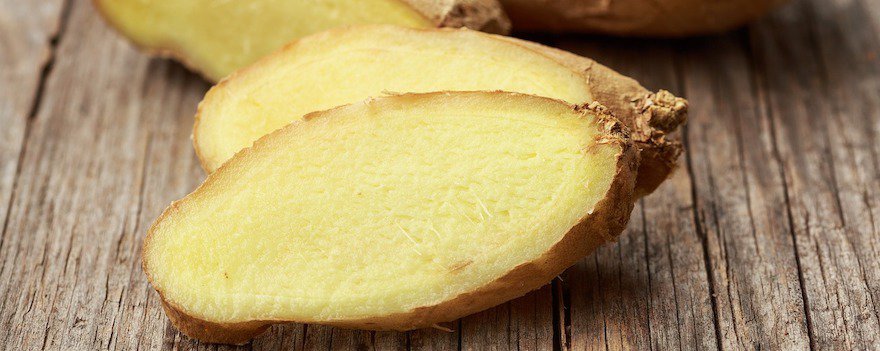
Unlike other foods, ginger even maintains or develops other properties when cooked or dried in powder form. Therefore, consuming it fresh is not the only way to benefit from its advantages, but it’s a good way to enjoy its spicy juice.
To choose it best, select a hard rhizome without mold and ensure its flesh is clear, juicy, and fragrant. Fresh and unpeeled, it can be kept for up to 3 weeks in the refrigerator.
Powdered Ginger
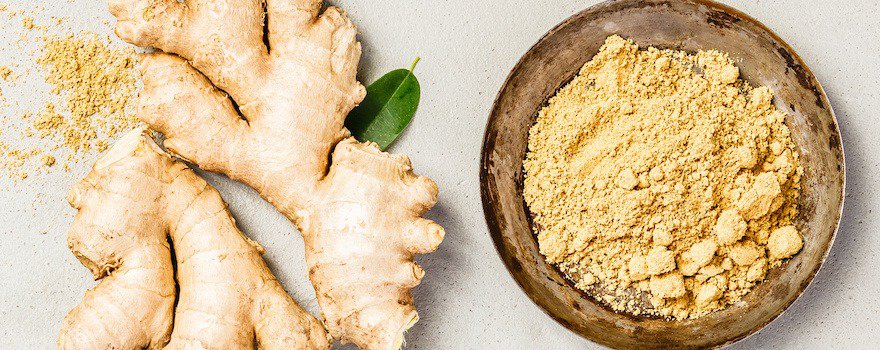
Powdered or ground ginger is obtained from mature rhizomes (harvested more than 7 months after planting) whose flavor is more pronounced than rhizomes intended to be consumed fresh. They are dried and then ground to obtain the powder.
{{{TEMP_MARK_45}}}
Ginger Infusion
An enjoyable and easy way to consume it daily is through ginger infusion. These infusions can be recommended for winter ailments, nausea, digestive problems. They can also be consumed without any specific issue to address, as they contribute to overall well-being.
Also read Ginger Infusion: Benefits and Preparation Tips
{{{TEMP_MARK_18}}}
{{{TEMP_MARK_81}}}
Ginger juice is another way to enjoy its benefits while savoring its spiciness. In Senegal, it is called Gnamakoudji, “spicy water”. Drinking ginger juice can be a great energy boost to start the day.
Also read Ginger Juice, Benefits and Recipes
It can be easily made at home: blend a peeled piece of rhizome with a little water, add lemon and brown sugar then more water, strain and keep refrigerated.
Ginger and Lemon
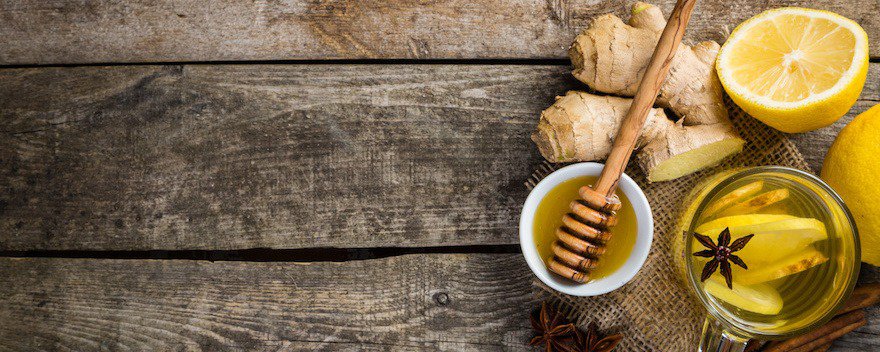
Ginger and lemon are two foods that combine particularly well! Not only in taste but also therapeutically. Given their individual benefits, their synergy is even more productive.
On one hand, this combination, thanks to its antiseptic and anti-inflammatory effects, effectively fights against colds, coughs, flu-like conditions… On the other hand, combining these two foods is a good way to detoxify the body.
It is advised to associate them as much as possible, for example, in an infusion by mixing a teaspoon of powdered ginger or a tablespoon if fresh and grated, and half a squeezed lemon with hot water.
Feel free to add honey to soften the drink, and consume on an empty stomach for better detox.
Ginger and Turmeric
Ginger and its cousin spice turmeric pair well in taste and also make a great health combo! One can especially consume them in soup form.
{{{TEMP_MARK_85}}}
⏳ Good news, ginger can be consumed daily without any particular restrictions.
⚖️ Just keep in mind that 10g of fresh ginger is equivalent to 1 to 2g dried.
⚖️ Pregnancy nausea: 2g dried/day
🍵 Infusion: 1g dried or 5g fresh grated per infusion, several times a day
Contraindications and Side Effects
At the indicated doses, there are no known contraindications or adverse effects. However, its anticoagulant properties make ginger a food to be consumed with caution if you have coagulation problems or are already taking anticoagulant medications.
Moreover, it is recommended for pregnant women to seek medical advice before starting a ginger course.
Detailed Nutritional Values
This data has been synthesized and verified for Darwin Nutrition by Laure Fourchaud, Doctor of Nutrition Physiology.
| {{{TEMP_MARK_87}}} | /100g | %DV* | /5g (1tsp) | %DV |
| Energy (kcal) | 336 | {{{TEMP_MARK_136}}} | {{{TEMP_MARK_136}}} | {{{TEMP_MARK_138}}} |
| Fiber (g) | {{{TEMP_MARK_139}}} | 47 | 0.71 | 2.35 |
| Water (g) | 9.66 | {{{TEMP_MARK_218}}} | 0.48 | {{{TEMP_MARK_218}}} |
| {{{TEMP_MARK_88}}} | ||||
| {{{TEMP_MARK_114}}} | 9.05 | {{{TEMP_MARK_145}}} | 0.45 | {{{TEMP_MARK_147}}} |
| Carbohydrates (g) | {{{TEMP_MARK_148}}} | {{{TEMP_MARK_127}}} | 2.92 | 1.12 |
| Of which sugars (g) | 3.39 | 3.77 | 0.17 | 0.19 |
| Fats (g) | 4.24 | 6.06 | 0.21 | 0.3 |
| Minerals | ||||
| Calcium (mg) | 114 | {{{TEMP_MARK_128}}} | 5.7 | 0.71 |
| Iron (mg) | 19.8 | 141.43 | 0.99 | 7.07 |
| {{{TEMP_MARK_118}}} | 0.48 | 48 | 0.02 | 2.4 |
| Magnesium (mg) | 214 | 57.07 | 10.7 | 2.85 |
| Manganese (mg) | {{{TEMP_MARK_166}}} | 1665 | {{{TEMP_MARK_{{{TEMP_MARK_208}}}}}} | {{{TEMP_MARK_130}}} |
| Phosphorus (mg) | {{{TEMP_MARK_208}}} | 24 | 8.4 | 1.2 |
| {{{TEMP_MARK_113}}} | 1320 | 66 | 66 | 3.3 |
| Sodium (mg) | 27 | 1.08 | 1.35 | 0.05 |
| {{{TEMP_MARK_124}}} | {{{TEMP_MARK_131}}} | 1.13 | 0 | 0.06 |
| Zinc (mg) | 3.64 | 36.4 | 0.18 | {{{TEMP_MARK_178}}} |
| Vitamins | ||||
| Vitamin A (mg) | 18 | 2.25 | 0.9 | {{{TEMP_MARK_180}}} |
| {{{TEMP_MARK_108}}} | {{{TEMP_MARK_213}}} | {{{TEMP_MARK_181}}} | {{{TEMP_MARK_182}}} | {{{TEMP_MARK_182}}} |
| {{{TEMP_MARK_98}}} | {{{TEMP_MARK_218}}} | {{{TEMP_MARK_218}}} | {{{TEMP_MARK_218}}} | {{{TEMP_MARK_218}}} |
| Vitamin E (mg) | {{{TEMP_MARK_218}}} | {{{TEMP_MARK_218}}} | {{{TEMP_MARK_218}}} | {{{TEMP_MARK_218}}} |
| Vitamin B1 (mg) | {{{TEMP_MARK_132}}} | {{{TEMP_MARK_184}}} | {{{TEMP_MARK_133}}} | 0.21 |
| Vitamin B2 (mg) | 0.17 | {{{TEMP_MARK_134}}} | {{{TEMP_MARK_187}}} | {{{TEMP_MARK_188}}} |
| Vitamin B3 (mg) | {{{TEMP_MARK_189}}} | {{{TEMP_MARK_135}}} | 0.48 | 3.01 |
| Vitamin B5 (mg) | 0.48 | 8 | 0.02 | 0.4 |
| Vitamin B6 (mg) | 0.63 | 45 | 0.03 | 2.25 |
| {{{TEMP_MARK_89}}} | 13 | 6.5 | 0.65 | {{{TEMP_MARK_198}}} |
| Vitamin B12 (µg) | {{{TEMP_MARK_218}}} | {{{TEMP_MARK_218}}} | {{{TEMP_MARK_218}}} | {{{TEMP_MARK_218}}} |
| Vitamin K (μg) | 0.8 | 1.07 | {{{TEMP_MARK_182}}} | 0.05 |
*%AR: % Reference intake for an adult
Antioxidants: (6)-gingerol, (10)-gingerol, shogaols
Sources and scientific studies
Altman RD, Marcussen KC, 2001. Effects of a ginger extract on knee pain in patients with osteoarthritis.
Ponmurugan Karuppiah, et Shyamkumar Rajaram, 2012. Antibacterial effect of Allium sativum cloves and Zingiber officinale rhizomes against multiple-drug resistant clinical pathogens.
Kwanjit Danwilai, Jitprapa Konmun, Bung-orn Sripanidkulchai, et Suphat Subongkot, 2017. Antioxidant activity of ginger extract as a daily supplement in cancer patients receiving adjuvant chemotherapy: a pilot study.
Estelle Viljoen, Janicke Visser, Nelene Koen, and Alfred Musekiwa, 2014. A systematic review and meta-analysis of the effect and safety of ginger in the treatment of pregnancy-associated nausea and vomiting.
Wu KL, Rayner CK, Chuah SK, Changchien CS, Lu SN, Chiu YC, Chiu KW, Lee CM, 2008. Effects of ginger on gastric emptying and motility in healthy humans.
Alizadeh-Navaei R, Roozbeh F, Saravi M, Pouramir M, Jalali F, Moghadamnia AA, 2008. Investigation of the effect of ginger on the lipid levels. A double-blind controlled clinical trial.
Suzanna M. Zick, D. Kim Turgeon, Shaiju K Vareed, Mack T. Ruffin, Amie J. Litzinger, Benjamin D Wright, Sara Alrawi, Daniel P. Normolle, Zora Djuric, and Dean E. Brenner, 2011. Phase II study of the Effects of Ginger Root Extract on Eicosanoids in Colon Mucosa in People at Normal Risk for Colorectal Cancer.
U.S. Department of Agriculture, Agricultural Research Service (2014). USDA National Nutrient Database for Standard Reference, Release 27. Nutrient Data Laboratory Home Page, http://www.ars.usda.gov/ba/bhnrc/ndl
Monograph Zingiber officinal (Ginger). Altern Med Rev 2003;8(3):331-5.Desaulniers Marguerite, Dubost Mireille. Table de composition des aliments, volume 1. Département de nutrition, Université de Montréal, Canada, 2003.
Encyclopedia Britannica. Ginger. Britannica.com


